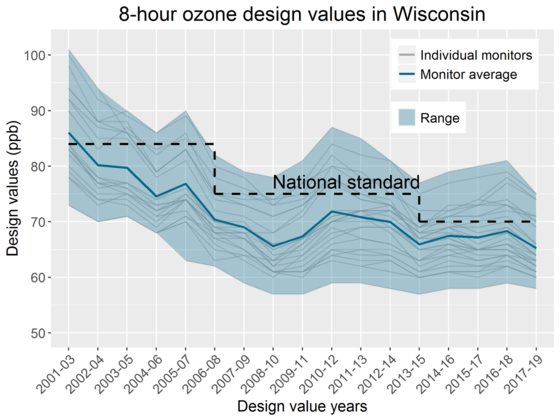New Study Shows Air Quality Improving In The Dairy State

The DNR’s 2020 Air Quality Trends Report confirms decreasing concentrations of most pollutants across the state. / Photo Credit: Wisconsin DNR
MADISON, Wis. – Wisconsin’s air quality is improving. The Wisconsin Department of Natural Resources (DNR) 2020 Air Quality Trends Report has been released and confirms decreasing concentrations of most pollutants across the state.
The report, which includes air quality data through 2019, finds that concentrations of most pollutants for which the Environmental Protection Agency (EPA) has set national air quality standards have decreased in all regions of the state since monitoring began. Due in part to these significant reductions, 95% of Wisconsin’s population lives in areas meeting all federal air quality standards.
This notable decrease in ozone concentrations allowed the EPA to recently determine that several lakeshore areas are now meeting federal ozone standards, including parts of Door and Sheboygan counties.
The report also includes updated emissions data, which shows that air pollutant emissions in Wisconsin decreased substantially from 2002 to 2017. Some highlights include:
- A 63% drop in emissions of nitrogen oxides (NOx) and a 58% drop in volatile organic compounds (VOCs), the compounds that form ground-level ozone;
- An 89% drop in sulfur dioxide (SO2) emissions; and
- A nearly 60% reduction in carbon monoxide emissions.
The 2020 report also includes updated maps of nitrogen dioxide (NO2) densities in the atmosphere, derived from National Aeronautics and Space Administration (NASA) satellite data. From 2006 to 2019, the Ozone Monitoring Instrument (OMI) on NASA’s Aura satellite observed reductions of NO2 across the entire state, with the largest reductions found in the Milwaukee area.
“State and federal air pollution control programs, as well as voluntary actions taken by companies and citizens, are responsible for the improvements in air quality in Wisconsin,” said DNR air program director Gail Good. “The Air Management Program will continue to work with our partners to study and resolve remaining air quality concerns.”
The 2020 Air Quality Trends Report, along with historic reports are available on DNR’s Air Quality webpage. Current Wisconsin air quality conditions can be found on the Wisconsin Air Quality Monitoring data webpage.
NOTE: This press release was submitted to Urban Milwaukee and was not written by an Urban Milwaukee writer. While it is believed to be reliable, Urban Milwaukee does not guarantee its accuracy or completeness.






















